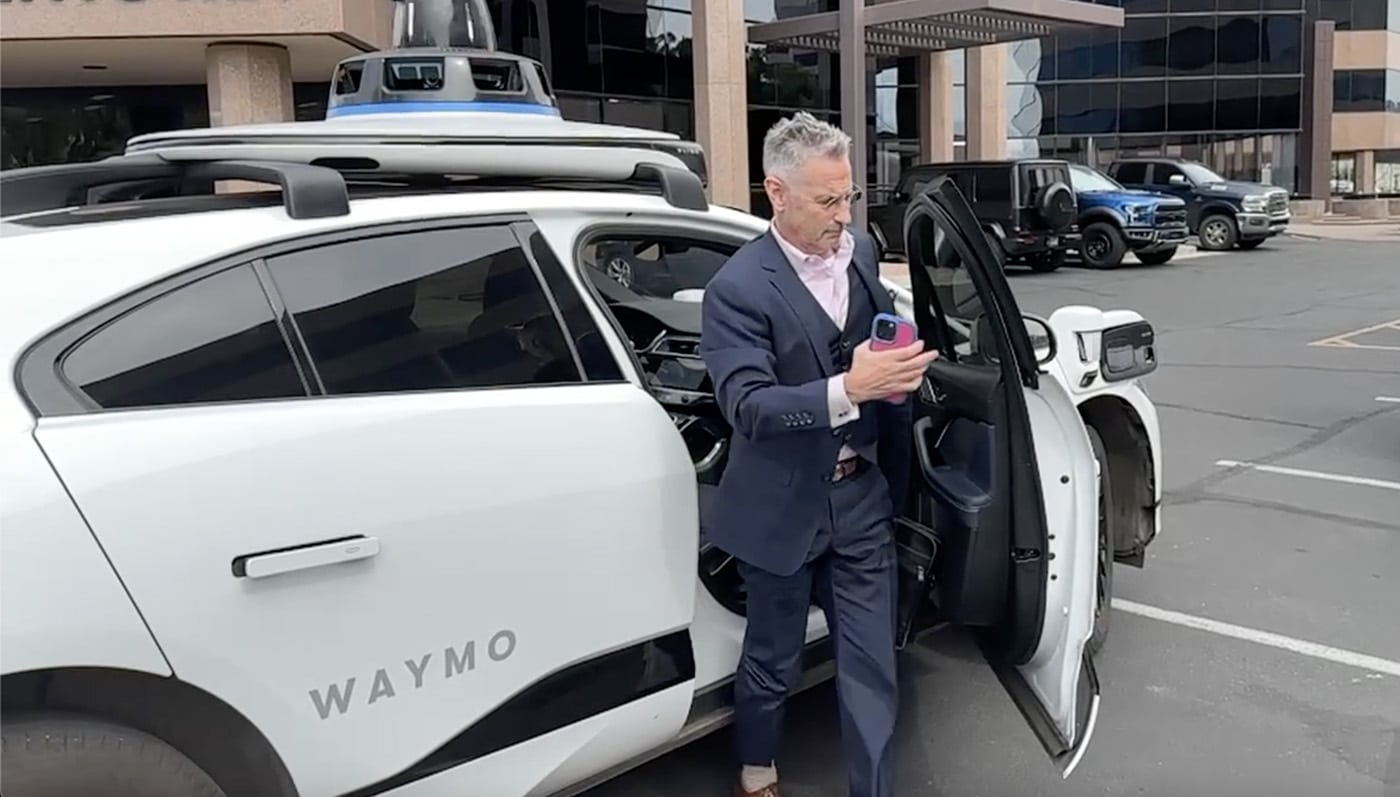Lamber Goodnow Injury Lawyers
Phoenix Office
Why I want Waymo to put me out of business
A plaintiff’s personal injury attorney’s perspective about robot taxis
A staggering 1.2 million people die every year worldwide in car accidents. Tens of millions of people are injured and trillions of dollars in associated damages are lost. The vast majority of car accidents, or an estimated 94%, are caused by human error. Consider this statistic from a 2023 Waymo Report. Compared to human drivers, the Waymo One was 6.7 times less likely to be in a crash resulting in injury and 2.3 times less likely to be in a police-reported crash.
As a personal injury attorney for 30+ years fighting for victims of catastrophic injuries caused by car accidents, I know the devastation individuals and their families face. It may come as some surprise that I trust autonomous vehicles more than human drivers. Well, it’s true! It’s my sincere hope that as self-driving cars evolve and become even safer, that there will be no need for personal injury attorneys related to car accidents. I want driverless cars to put me out of business!
I’m also a public safety advocate and have written extensively over the years about technology that makes us safer. Living in Phoenix, one of the main hubs for Waymo’s robot taxis, I’ve watched as Waymo robot taxis have become nearly ubiquitous on roads across the Phoenix metro to the point of where the thrill of watching a car drive by with an empty front seat is no longer novel, but part of our daily routine. There have also been some instances of erratic behavior and software recalls well covered by the media, but fortunately no new serious injuries as of this writing.

“It’s my sincere hope that as self-driving cars evolve and become even safer, that there will be no need for personal injury attorneys related to car accidents.”
Public opinion
Most people don’t trust self-driving cars. Almost every public opinion study points to the fact that we just aren’t ready to accept this technology. For example, Forbes finds that 93% of Americans worry about safety and technology malfunctions with self-driving cars. Why is this? Well, according to a J.D. Power AV Confidence Report published late last year, “consumers show low readiness on all metrics with the lowest level of comfort riding in a fully automated, self-driving vehicle and using fully automated, self-driving public transit.”
These studies are compounded by the media highlighting testing failures. The fact is, those studies and media reports get a lot of national eyeballs, but the vast majority of Americans have no understanding of the safety of driverless cars because they have not heard about the underlying technology nor have they reviewed the publicly available safety data.
More importantly, most people in the United States have never been in a self-driving car, no less a Waymo robot taxi. This explains why confidence soars for consumers who have ridden in a robotaxi in Phoenix or San Francisco, areas where residents are familiar with AV testing and development.
Arizona leads the way in holding self-driving cars accountable for accidents they cause
A.R.S. section 28-663 states that if such an accident occurs, the autonomous vehicle owner or a person on behalf of the vehicle owner must promptly contact a law enforcement agency to report the accident. And it further requires that the vehicle owner, a person on behalf of the vehicle owner or the fully autonomous vehicle make the owner’s name and address and the registration number of the vehicle available to either the person struck by the vehicle or the occupants of or a person attending a vehicle that is involved in the accident.
A.R.S. section 28-661 states that a self-driving car must stop at the scene until the duty to give information and assistance is satisfied if there is an accident resulting in injury, death or property damage.
Arizona leads the way in holding self-driving cars accountable for accidents they cause
A.R.S. section 28-663 states that if such an accident occurs, the autonomous vehicle owner or a person on behalf of the vehicle owner must promptly contact a law enforcement agency to report the accident. And it further requires that the vehicle owner, a person on behalf of the vehicle owner or the fully autonomous vehicle make the owner’s name and address and the registration number of the vehicle available to either the person struck by the vehicle or the occupants of or a person attending a vehicle that is involved in the accident.
A.R.S. section 28-661 states that a self-driving car must stop at the scene until the duty to give information and assistance is satisfied if there is an accident resulting in injury, death or property damage.

My own experience in a Waymo robot taxi
I am naturally cautious and generally skeptical. I understand risk and have a good sense of when risk leads to danger. It’s my nature and has served me well as an advocate for seriously injured car accident victims for more than 30 years. Until recently, I’d never been in a robot taxi. I’ve seen Waymos on the street, and have often wondered myself, how safe are autonomous cars? I have to admit, as much of an advocate as I am for advances in technology that make us more efficient and safer, having no control over the car that I am riding in scared the pants off me! However, I’ve studied the data and watched the Waymo technology evolve around me here in Phoenix. I decided it was time for me to jump in.
My first experience was going from the mall next to my office in Central Phoenix down to City Hall, about a 30-minute drive on local roads. The process of hailing the vehicle and arriving at your destination, along with the cost, is almost identical to that of Uber or Lyft. You pay through the Waymo One app, which holds all the information about your ride, wait for your vehicle, and then get picked up and dropped off at your location.
While it was a bit of a challenge to determine where the Waymo would stop to pick me up for the ride, the walk was doable. The app told me it would wait for 5 minutes. With the press of a ‘Start Ride’ button, I was off. Just navigating the parking lot of the local mall was amazing to me. There were cars pulling out, pedestrians crossing in odd places and a lot of congestion. But the Waymo handled these conditions smoothly and without incident. I was a little freaked out about how as soon I hit “start ride” the car pulled off. If it were me, I would have checked the traffic around me, but the Waymo had already done that with its 360-degree sensors.
As we turned onto a main thoroughfare called Camelback Road, I was expecting sharp turns and abrupt stops, but the Waymo’s consistent speed and spatial awareness of objects put me at ease. Honestly, it felt like I was being driven around by a Driver’s Ed instructor. As a passenger, I felt safe knowing that the robot driver was cautious rather than aggressive and fluid rather than jerky. After 10 minutes, I had built a sense of trust about the ride, somewhat like what I feel with a really good rideshare driver.
At one point, the Waymo seemed a little bit unsettled by surrounding traffic and it made some lane changes that seemed odd, but I still felt safe. In another instance, when we were on a two-lane road, the Waymo detected a car pulling out of a parallel parking spot in the opposite direction and applied its brakes hard. I think I would not have applied my brakes in that situation. Is it perfect? No. But is it better and safer than a human driver? Yes, by far. With just one ride, Waymo removed my natural fear and significantly eliminated my skepticism.
During the ride, I decided to call support to ask them why the Waymo was not driving on the highway. I could have reached my destination 15 minutes faster. It seemed odd because local news reports at that time said that Waymos were allowed on our highways. The support representative was very candid and answered my questions. He said that they were testing, but that most of the cars are still programmed to stay on local roads. Since my ride, I have seen Waymos on our highways in Phoenix and am glad to see that the technology is continuing to advance. I’m happy they are not rushing it.
Watch Marc react to his 1st Waymo ride:

Final thoughts
From the perspective of a personal injury attorney, I can tell you that all those human factors that cause bad accidents and catastrophic injuries simply do not exist. Waymos do not get distracted, take calls, respond to texts, get drunk, smoke, apply makeup, unwrap food, reach behind them, drive aggressively, miss a blind spot or do any number of things that would likely cause an accident. Full stop.
Unlike human drivers, Waymo taxis get smarter with every ride. The vehicle continuously collects and stores data from its millions of miles of driving experience to anticipate possible scenarios. We mere humans couldn’t possibly remember every detail of every time we’ve driven our cars, but the Waymo can, and it uses that knowledge to provide a safer ride.
The more miles the Waymos complete, the more information it learns, the more that information is applied across the system, the fewer accidents will occur, and ultimately the fewer deaths and injuries people will suffer.
I recognize how difficult it is for people to come to terms with riding in a driverless vehicle and I can’t blame them unless they are unwilling to try it. The ultimate triumph of this technology is buried under highly publicized media coverage of its shortcomings. This technology isn’t perfect and there will be occasional accidents. However, we are dealing with a huge advantage here. Remember, 1.2 million people die each year from car accidents. If we can reduce that number by even half in the next 10 years, why wouldn’t we at least try?
The technology has already pulled up to our doorsteps. We just need to get in. This is a binary choice in which I see two possible outcomes: Either we continue to be okay with the number of people dying every year from accidents caused by human error, or we scale this technology to save lives.
Locations
Lamber Goodnow Injury Lawyers
Phoenix, Arizona
602-ARIZONA (602-274-9662)
2394 E Camelback Rd #600
Phoenix, AZ 85016
Lamber Goodnow Injury Lawyers
Denver, Colorado
303-800-8888
1330 Logan St Suite B2,
Denver, CO 80203
Lamber Goodnow Injury Lawyers
Tucson, Arizona
520-477-7777
4023 E. Grant Rd Suite 101,
Tucson AZ 85712.
